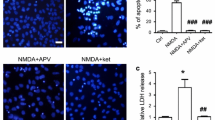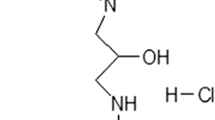Abstract
Transient receptor potential channel 1 (TRPC1; a cation channel activated by store depletion and/or through an intracellular messenger) is expressed in a variety of tissues, including the brain. To study the physiological function of TRPC1, we investigated the role of endogenously expressed TRPC1 in glutamate-induced cell death, using the murine hippocampal cell line HT22. Knocking down TRPC1 mRNA using TRPC1-shRNA or blocking of TRPC channels using 2-APB (≥200 μM) robustly attenuated glutamate-induced cell death after 24 h of incubation with 5 mM glutamate. Glutamate toxicity in HT22 cells seems to involve metabotropic glutamate receptor mGluR5 since MPEP (2-methyl-6-(phenylethynyl)-pyridine), an mGluR5 antagonist (≥100 μM), abrogated glutamate toxicity. Furthermore, a direct activation of mGluR5 by CHPG [(RS)-chloro-5-hydroxyphenylglycine; 100 μM or 300 μM] promoted HT22 cell death. TRPC1 knock-down markedly reduced CHPG-induced cell death. These observations suggest that glutamate-induced cell death in HT22 cells activates mGluR5 receptors, which significantly increases Ca2+ influx through TRPC1 channels. TRPC1 knock-down prevented glutamate- and CHPG-induced cell death, suggesting that glutamate-induced toxicity in HT22 cells is mediated through TRPC1 channels and an mGluR5-dependent pathway. Together, this work provides evidence for a novel receptor activation pathway of TRPC1 in glutamate-induced toxicity.



Similar content being viewed by others
Abbreviations
- 2-APB:
-
2-Aminoethoxydiphenyl borate
- CHPG:
-
(RS)-Chloro-5-hydroxyphenylglycine
- DAG:
-
Diacylglycerol
- glu:
-
Glutamate
- IP3 :
-
Inositol triphosphate
- mGluR:
-
Metabotropic receptors
- MPEP:
-
2-Methyl-6-(phenylethynyl)-pyridine
- PIP2 :
-
Phosphatidylinositol biphosphate
- PLC:
-
Phospholipase C
- ROS:
-
Reactive oxygen species
- shRNA:
-
Short hairpin RNA
- TRPC1:
-
Transient receptor potential channel 1
References
Allen JW, Knoblach SM, Faden AI (2000) Activation of group I metabotropic glutamate receptors reduces neuronal apoptosis but increases necrotic cell death in vitro. Cell Death Differ 7(5):470–476
Berrout J, Jin M, O'Neil RG (2012) Critical role of TRPP2 and TRPC1 channels in stretch-induced injury of blood–brain barrier endothelial cells. Brain Res 1436:1–12
Choi DW (1987) Ionic dependence of glutamate neurotoxicity. J Neurosci 7(2):369–379
Choi BH, Hur EM, Lee JH, Jun DJ, Kim KT (2006) Protein kinase Cdelta-mediated proteasomal degradation of MAP kinase phosphatase-1 contributes to glutamate-induced neuronal cell death. J Cell Sci 119(Pt 7):1329–1340
Copani A, Bruno V, Battaglia G et al (1995) Activation of metabotropic glutamate receptors protects cultured neurons against apoptosis induced by beta-amyloid peptide. Mol Pharmacol 47(5):890–897
Coyle JT, Puttfarcken P (1993) Oxidative stress, glutamate, and neurodegenerative disorders. Science 262(5134):689–695
Davis JB, Maher P (1994) Protein kinase C activation inhibits glutamate-induced cytotoxicity in a neuronal cell line. Brain Res 652(1):169–173
Dietrich A, Mederos y Schnitzler M, Kalwa H, Storch U, Gudermann T (2005) Functional characterization and physiological relevance of the TRPC3/6/7 subfamily of cation channels. Naunyn Schmiedebergs Arch Pharmacol 371(4):257–265
Favaron M, Manev H, Siman R et al (1990) Down-regulation of protein kinase C protects cerebellar granule neurons in primary culture from glutamate-induced neuronal death. Proc Natl Acad Sci U S A 87(5):1983–1987
Ha JS, Park SS (2006) Glutamate-induced oxidative stress, but not cell death, is largely dependent upon extracellular calcium in mouse neuronal HT22 cells. Neurosci Lett 393(2–3):165–169
Isaev NK, Zorov DB, Stelmashook EV, Uzbekov RE, Kozhemyakin MB, Victorov IV (1996) Neurotoxic glutamate treatment of cultured cerebellar granule cells induces Ca2+-dependent collapse of mitochondrial membrane potential and ultrastructural alterations of mitochondria. FEBS Lett 392(2):143–147
Kim SJ, Kim YS, Yuan JP, Petralia RS, Worley PF, Linden DJ (2003) Activation of the TRPC1 cation channel by metabotropic glutamate receptor mGluR1. Nature 426(6964):285–291
Kim DS, Ryu HJ, Kim JE, Kang TC (2013) The reverse roles of transient receptor potential canonical channel-3 and -6 in neuronal death following pilocarpine-induced status epilepticus. Cell Mol Neurobiol 33(1):99–109
Lea PM, Movsesyan VA, Faden AI (2005) Neuroprotective activity of the mGluR5 antagonists MPEP and MTEP against acute excitotoxicity differs and does not reflect actions at mGluR5 receptors. Br J Pharmacol 145(4):527–534
Lei B, Tan X, Cai H, Xu Q, Guo Q (1994) Effect of moderate hypothermia on lipid peroxidation in canine brain tissue after cardiac arrest and resuscitation. Stroke 25(1):147–152
Li Y, Maher P, Schubert D (1997) A role for 12-lipoxygenase in nerve cell death caused by glutathione depletion. Neuron 19(2):453–463
Li Y, Maher P, Schubert D (1998) Phosphatidylcholine-specific phospholipase C regulates glutamate-induced nerve cell death. Proc Natl Acad Sci U S A 95(13):7748–7753
Li J, Kato K, Ikeda J, Morita I, Murota S (2001) A narrow window for rescuing cells by the inhibition of calcium influx and the importance of influx route in rat cortical neuronal cell death induced by glutamate. Neurosci Lett 304(1–2):29–32
Lin Y, Chen F, Zhang J et al (2013) Neuroprotective effect of resveratrol on ischemia/reperfusion injury in rats through TRPC6/CREB pathways. J Mol Neurosci 50(3):504–513
Macho A, Hirsch T, Marzo I et al (1997) Glutathione depletion is an early and calcium elevation is a late event of thymocyte apoptosis. J Immunol 158(10):4612–4619
Madsen CP, Klausen TK, Fabian A, Hansen BJ, Pedersen SF, Hoffmann EK (2012) On the role of TRPC1 in control of Ca2+ influx, cell volume, and cell cycle. Am J Physiol Cell Physiol 303(6):C625–C634
Molz S, Decker H, Dal-Cim T et al (2008) Glutamate-induced toxicity in hippocampal slices involves apoptotic features and p38 MAPK signaling. Neurochem Res 33(1):27–36
Murphy TH, Miyamoto M, Sastre A, Schnaar RL, Coyle JT (1989) Glutamate toxicity in a neuronal cell line involves inhibition of cystine transport leading to oxidative stress. Neuron 2(6):1547–1558
Narayanan KL, Irmady K, Subramaniam S, Unsicker K, von Bohlen und Halbach O (2008) Evidence that TRPC1 is involved in hippocampal glutamate-induced cell death. Neurosci Lett 446(2–3):117–122
O'Leary DM, Movsesyan V, Vicini S, Faden AI (2000) Selective mGluR5 antagonists MPEP and SIB-1893 decrease NMDA or glutamate-mediated neuronal toxicity through actions that reflect NMDA receptor antagonism. Br J Pharmacol 131(7):1429–1437
Phelan KD, Shwe UT, Abramowitz J et al (2013) Canonical transient receptor channel 5 (TRPC5) and TRPC1/4 contribute to seizure and excitotoxicity by distinct cellular mechanisms. Mol Pharmacol 83(2):429–438
Sagara Y, Schubert D (1998) The activation of metabotropic glutamate receptors protects nerve cells from oxidative stress. J Neurosci 18(17):6662–6671
Sagara Y, Dargusch R, Chambers D, Davis J, Schubert D, Maher P (1998) Cellular mechanisms of resistance to chronic oxidative stress. Free Radic Biol Med 24(9):1375–1389
Sekaran S, Lall GS, Ralphs KL et al (2007) 2-Aminoethoxydiphenylborane is an acute inhibitor of directly photosensitive retinal ganglion cell activity in vitro and in vivo. J Neurosci 27(15):3981–3986
Siman R, Noszek JC (1988) Excitatory amino acids activate calpain I and induce structural protein breakdown in vivo. Neuron 1(4):279–287
Stanciu M, Wang Y, Kentor R et al (2000) Persistent activation of ERK contributes to glutamate-induced oxidative toxicity in a neuronal cell line and primary cortical neuron cultures. J Biol Chem 275(16):12200–12206
Strasser U, Lobner D, Behrens MM, Canzoniero LM, Choi DW (1998) Antagonists for group I mGluRs attenuate excitotoxic neuronal death in cortical cultures. Eur J Neurosci 10(9):2848–2855
Tan S, Sagara Y, Liu Y, Maher P, Schubert D (1998a) The regulation of reactive oxygen species production during programmed cell death. J Cell Biol 141(6):1423–1432
Tan S, Wood M, Maher P (1998b) Oxidative stress induces a form of programmed cell death with characteristics of both apoptosis and necrosis in neuronal cells. J Neurochem 71(1):95–105
Tozzi A, Bengtson CP, Longone P et al (2003) Involvement of transient receptor potential-like channels in responses to mGluR-I activation in midbrain dopamine neurons. Eur J Neurosci 18(8):2133–2145
Tu CL, Chang W, Bikle DD (2005) Phospholipase cgamma1 is required for activation of store-operated channels in human keratinocytes. J Invest Dermatol 124(1):187–197
von Bohlen Und Halbach O, Hinz U, Unsicker K, Egorov AV (2005) Distribution of TRPC1 and TRPC5 in medial temporal lobe structures of mice. Cell Tissue Res 322(2):201–206
Wu J, Shih HP, Vigont V et al (2011) Neuronal store-operated calcium entry pathway as a novel therapeutic target for Huntington's disease treatment. Chem Biol 18(6):777–793
Acknowledgments
We wish to thank H. Bading for his indispensable help for this project. We also want to thank Alexei Egorov for providing reagents and Jutta Fey for technical assistance in cell culture. This study was supported by a grant from the German Research Foundation (SFB636/A5).
Competing interests
There are no competing interests in regards to this manuscript.
Author information
Authors and Affiliations
Corresponding author
Electronic supplementary material
Below is the link to the electronic supplementary material.
Supplementary Fig. 1
Quantification of TRPC1 mRNA levels normalized to beta actin mRNA levels on the treated cells (n = 3). TRPC1-shRNA significantly reduces TRPC1 mRNA levels (determined by ANOVA followed by Newman–Keuls multiple comparison test). (JPEG 25 kb)
Rights and permissions
About this article
Cite this article
Narayanan, K.L., Subramaniam, S., Bengston, C.P. et al. Role of Transient Receptor Potential Channel 1 (TRPC1) in Glutamate-Induced Cell Death in the Hippocampal Cell Line HT22. J Mol Neurosci 52, 425–433 (2014). https://doi.org/10.1007/s12031-013-0171-9
Received:
Accepted:
Published:
Issue Date:
DOI: https://doi.org/10.1007/s12031-013-0171-9




